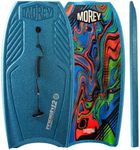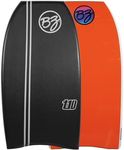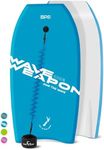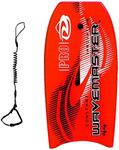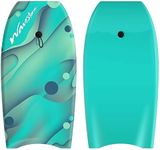Buying Guide for the Best Boogie Boards For Adults
Choosing the right boogie board for adults involves understanding various specifications that can affect your overall experience in the water. Whether you're a beginner or an experienced rider, selecting a board that matches your skill level, body type, and the type of waves you'll be riding is crucial. Here are some key specs to consider when picking a boogie board for adults and how to navigate them to find the best fit for you.SizeThe size of the boogie board is one of the most important factors to consider. It affects your control, speed, and overall performance. Boogie boards are typically measured in inches, and the right size for you depends on your height and weight. Generally, the board should reach up to your belly button when stood on end. For heavier or taller adults, a longer board (42 inches or more) provides better buoyancy and stability. For lighter or shorter adults, a shorter board (39-41 inches) offers more maneuverability. Choose a size that allows you to comfortably control the board while providing enough buoyancy to keep you afloat.
Core MaterialThe core material of a boogie board determines its flexibility, durability, and performance in different water temperatures. The two main types of core materials are polyethylene (PE) and polypropylene (PP). PE cores are more flexible and suitable for colder water, providing a softer ride. PP cores are stiffer and better for warmer water, offering more speed and responsiveness. If you plan to ride in various water temperatures, consider a board with a combination core (PE and PP) for versatility. Choose a core material that matches the typical water conditions you'll be riding in.
Deck MaterialThe deck material of a boogie board affects its comfort and grip. Most decks are made from either crosslink or Surlyn. Crosslink decks are softer and provide a more comfortable ride, making them ideal for beginners or those who prioritize comfort. Surlyn decks are more durable and offer better performance, making them suitable for more experienced riders who need a board that can withstand more aggressive use. Consider your comfort level and riding style when choosing the deck material.
Tail ShapeThe tail shape of a boogie board influences its maneuverability and control. The two most common tail shapes are crescent and bat tail. Crescent tails provide better control and are ideal for all-around use, making them suitable for beginners and intermediate riders. Bat tails offer more speed and maneuverability, making them better for advanced riders who want to perform tricks and ride more challenging waves. Choose a tail shape that matches your skill level and the type of waves you plan to ride.
RailsThe rails, or edges, of a boogie board affect its grip on the wave and overall performance. Rails are typically described by their angle, with 60/40 and 50/50 being the most common. 60/40 rails provide a good balance of speed and control, making them suitable for most riders. 50/50 rails offer more speed but less control, making them better for advanced riders who prioritize speed over maneuverability. Consider your riding style and skill level when choosing the rail configuration.
StringerA stringer is a rod that runs through the core of the boogie board, providing additional strength and stiffness. Boards with stringers are more durable and offer better performance, especially in larger waves. Single stringers are common and provide a good balance of flexibility and strength. Double or triple stringers offer even more stiffness and durability, making them suitable for heavier riders or those who ride in powerful waves. If you plan to ride in challenging conditions or need extra durability, consider a board with a stringer.

